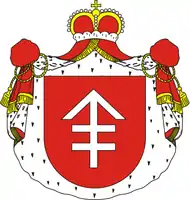Kazimierz Nestor Sapieha
Prince Kazimierz Nestor Sapieha (1757–1798) was a Polish-Lithuanian noble (szlachcic) and one the creators of the 3 May Constitution.
Prince Kazimierz Nestor Sapieha | |
|---|---|
.jpg.webp) Portrait by Józef Pitschmann (1787)  | |
| Coat of arms | Lis |
| Born | 14 February 1757 Brześć Litewski, Polish–Lithuanian Commonwealth |
| Died | 25 May 1798 (aged 41) Vienna, Austrian Empire |
| Noble family | Sapieha |
| consort | Anna Cetner h. Przerowa |
| Father | Jan Sapieha |
| Mother | Elżbieta Branicka |
Biography
Early life and career
Kazimierz Sapieha was educated at the Knight School in Warsaw from 1767 until 1771, and later studied in Italy.[1] Upon his return he served as Artillery General of Lithuania, from 1773 to 1793.[1] As Deputy from Brzesc Litewski, he participated in several Sejms.[1] Most notably, from 1790 he participated in the Four-Year Sejm in Warsaw, and became Sejm Marshal from 6 October 1788 until 29 May 1792, and Marshal of the Lithuanian Confederation.[1]
Politics
An early supporter of the magnate opposition to any liberalization (his uncle Hetman Franciszek Ksawery Branicki was its leader), Sapieha changed his position under the influence of Stanisław Małachowski, and became a supporter of reforms, and the 3 May Constitution.[1] He strongly protested, when King Stanisław August Poniatowski joined the Targowica Confederation, and this so angered Sapieha, that he decided to leave Poland. He briefly settled in Dresden.[1] After the outbreak of the Kościuszko Uprising, he returned to his homeland and participated in the uprising, holding the rank of an Artillery Captain.[1] After the Uprising collapsed, he left Poland again, and spent the rest of his life in exile in Vienna, where he died 1798.[1]
Awards
- Knight of the Order of the White Eagle, awarded on January 1, 1779.
References
- Jacek Jędruch (1998). Constitutions, elections, and legislatures of Poland, 1493–1977: a guide to their history. EJJ Books. pp. 197–198. ISBN 978-0-7818-0637-4. Retrieved 13 August 2011.
